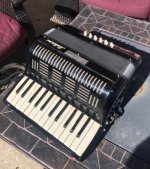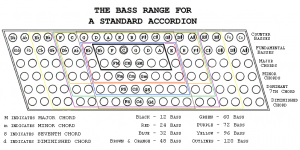SamIII
Newbie
I came across this Ballarini accordion in a secondhand store. I knew nothing about it except that it looked like it needed a home, so I bought it. Based on documents in the case it appears to have been made in the late 50s or early 60s. It needs a little work as some of the keys and buttons don't play correctly. Other than that it appears to be in good shape. There are no obvious chips/cracks/damage, etc. I'll be taking it apart soon to see what it needs. I'm looking forward to restoring this instrument, learning to play it, and playing it in a Bluegrass band.
Owning an accordion was not on my list of things to own, but I've always like their sound. Accordions have a unique image. They are right there with banjos and harmonicas of which I play both. I think it and I will get along well.
I found this forum while searching for information on Ballarini accordions. I'm hoping that someone here can tell me a little bit about Ballarini accordions in general and this instrument specifically. A Google search of Ballarini doesn't lead to much. I'm also looking for some thoughts, hints, suggestions, and comments on playing an accordion.
Thanks for any help, advice, and comments.
Sam

Owning an accordion was not on my list of things to own, but I've always like their sound. Accordions have a unique image. They are right there with banjos and harmonicas of which I play both. I think it and I will get along well.
I found this forum while searching for information on Ballarini accordions. I'm hoping that someone here can tell me a little bit about Ballarini accordions in general and this instrument specifically. A Google search of Ballarini doesn't lead to much. I'm also looking for some thoughts, hints, suggestions, and comments on playing an accordion.
Thanks for any help, advice, and comments.
Sam


